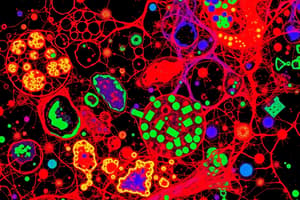Podcast
Questions and Answers
What is the primary function of the Abbe condenser in a compound microscope?
What is the primary function of the Abbe condenser in a compound microscope?
- To hold the slide in place
- To adjust the stage height
- To illuminate the specimen with halogen light
- To condense and focus light onto the stage (correct)
Which component of the compound microscope is responsible for holding the slide in position?
Which component of the compound microscope is responsible for holding the slide in position?
- The stage clips (correct)
- The coarse adjustment control
- The iris diaphragm
- The mirror
What is the purpose of the coarse and fine adjustment controls on a compound microscope?
What is the purpose of the coarse and fine adjustment controls on a compound microscope?
- To modify the mechanical stage's position
- To reflect light into the base
- To control the intensity of the light
- To adjust the focus of the microscope (correct)
How does the bottom lens or field diaphragm function in microscopy?
How does the bottom lens or field diaphragm function in microscopy?
What illuminates the specimen most commonly in modern compound microscopes?
What illuminates the specimen most commonly in modern compound microscopes?
What is the primary source of illumination for a compound microscope?
What is the primary source of illumination for a compound microscope?
What is the function of the eyepiece in a compound microscope?
What is the function of the eyepiece in a compound microscope?
How is the total magnification of a compound microscope calculated?
How is the total magnification of a compound microscope calculated?
Which part of the microscope rotates to change the objective lens in use?
Which part of the microscope rotates to change the objective lens in use?
What is the magnification power of a typical ocular lens found in a compound microscope?
What is the magnification power of a typical ocular lens found in a compound microscope?
Which of the following is NOT a standard common optical lens magnification for a compound microscope?
Which of the following is NOT a standard common optical lens magnification for a compound microscope?
What component of a compound microscope supports the entire structure and holds it stable?
What component of a compound microscope supports the entire structure and holds it stable?
What type of compound microscope includes a built-in light source?
What type of compound microscope includes a built-in light source?
What does microscopy specifically allow scientists to do?
What does microscopy specifically allow scientists to do?
Who is credited with the invention of the earliest microscope?
Who is credited with the invention of the earliest microscope?
What was Anton van Leeuwenhoek known for?
What was Anton van Leeuwenhoek known for?
Which microorganism did Robert Hooke first describe in the 1660s?
Which microorganism did Robert Hooke first describe in the 1660s?
How much could Anton van Leeuwenhoek's microscopes magnify objects?
How much could Anton van Leeuwenhoek's microscopes magnify objects?
Which statement best describes a key development facilitated by the microscope?
Which statement best describes a key development facilitated by the microscope?
Why was early awareness of diseases like the black plague vague?
Why was early awareness of diseases like the black plague vague?
What term did Anton van Leeuwenhoek use to refer to microorganisms he observed?
What term did Anton van Leeuwenhoek use to refer to microorganisms he observed?
Flashcards are hidden until you start studying
Study Notes
Overview of Microscopy
- Microscopy involves using microscopes to observe samples that are not visible to the naked eye due to resolution limits.
- Essential for investigating biological life, including identification and structure of microorganisms.
- Microorganisms play a crucial role in diagnosing infectious diseases.
Historical Development of the Microscope
- Early observation of food spoilage led to questioning disease causation, evident in historical occurrences like the black plague and smallpox.
- True understanding of microorganisms emerged with the invention of early microscopes.
Key Figures in Microscopy Development
- Hans and Zacharias Janssen: Invented the first microscopes around 1590.
- Robert Hooke (1660s): Documented the first microbes; described mold found on a book's sheepskin cover, illustrating Mucor species.
- Anton van Leeuwenhoek (1632-1723): Constructed over 250 microscopes with up to 300x magnification; coined "animalcules" for bacteria and protozoa, garnering the title "father of microbiology" with over 100 publications.
Types of Microscopes
Compound Microscope
- Consists of multiple lenses, typically magnifying up to 1000x, using visible light as illumination.
- Contains two lens systems: an eyepiece (ocular) and objective lenses placed above the specimen.
Key Components of a Compound Microscope
- Eyepiece (Ocular Lens): Lens through which the observer looks, typically magnifying between 5x and 30x.
- Monocular/Binocular Head: Connects eyepieces to the objective lenses.
- Arm: Supports the microscope head and connects to the base.
- Nosepiece: Holds and rotates the objective lenses.
- Base: Supports the microscope and houses illumination.
Objective Lenses and Magnification
- Common objective lenses: 4x, 10x, 40x, and 100x.
- Total magnification = eyepiece magnification x objective lens magnification (e.g., 10x eyepiece with 40x objective = 400x total).
Additional Components and Functions
- Stage: Platform for slides; may be mechanically adjustable.
- Stage Clips: Hold slides securely in place.
- Aperture/Iris Diaphragm: Controls light reaching the specimen.
- Abbe Condenser: Focuses light onto the stage, enhancing image clarity.
- Adjustment Controls: Coarse and fine knobs adjust focus, enhancing detail visibility.
- Mirror and Illumination: Earlier models used mirrors; modern equipment typically uses low voltage halogen bulbs.
Practical Applications
- Microscopes are essential for observing cellular structures and microorganisms, contributing significantly to fields like microbiology and medicine.
Presentation Acknowledgment
- Presentation delivered by Princess Mae Peria.
Studying That Suits You
Use AI to generate personalized quizzes and flashcards to suit your learning preferences.




